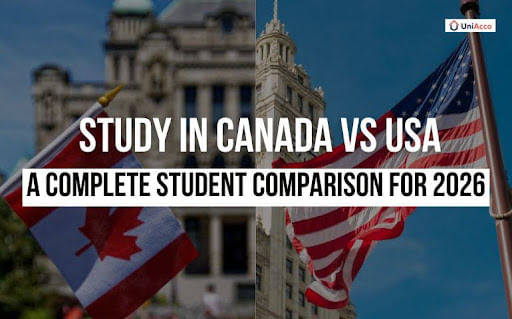For international students, deciding between Canada and the USA goes beyond classroom learning. The USA, hosting over 1.1 million students in 2023–24, offers globally renowned universities and vast career opportunities. Canada, on the other hand, stands out for its affordability, safety, and smoother post-study work options. Tuition fees, living costs, scholarship availability, and visa rules vary considerably, making informed research essential.
This blog presents a detailed comparison of both destinations, examining academics, lifestyle, finances, and career prospects, giving you actionable insights to decide where to study in Canada vs USA in 2026.
Study in Canada vs USA: Key Differences at a Glance
| Aspect | Level | Canada | USA |
| Degree Duration | UG | 3–4 years | 4 years |
| PG | 1–2 years | 1–2 years (may vary by program) | |
| Tuition Fees | UG | CAD 15,700 to CAD 53,538 | USD 25,000 – USD 50,000 |
| PG | CAD 13,742 to CAD 45,800 | USD 20,000 – USD 60,000 | |
| Degree Structure | — | Structured curriculum with fixed core subjects and limited electives; strong emphasis on co-ops and practical exposure | Flexible curriculum with majors/minors; students can customise courses across departments |
| Assessment Style | — | Mix of assignments, labs, projects, midterms, final exams, and co-op evaluations | Continuous assessment through quizzes, assignments, group projects, presentations, midterms & finals |
From campus halls to private studios, discover safe, fully furnished student housing that fits your budget. Study and live comfortably with UniAcco.
Student Accommodation in CanadaStudying in Canada Vs USA: Academic Differences
Canadian Education System Overview
Canada boasts a highly structured, research-oriented education system, supported by globally ranked universities and student-centric learning environments. By the end of 2024, it welcomed 997,820 international students (CBIE), underscoring its reputation as a top-tier study destination.
Emphasising experiential learning, Canadian programs integrate co-ops, internships, and industry-driven projects, equipping students with practical skills and real-world experience that make them career-ready from day one.
Types of Universities in Canada
- Public Universities in Canada
Public universities are funded by provincial governments and offer affordable, high-quality education, outstanding research, and a diverse range of programmes, especially valued by international students.
| University | Location | Known For |
| University of Toronto | Ontario | Leading global research university; consistently top-ranked in medicine, business, engineering, AI, and computer science; strong industry partnerships and innovation output. |
| University of British Columbia | British Columbia | Excellence in life sciences, sustainability and climate research, forestry, and computer science; highly regarded co-op programmes and strong international diversity. |
| McGill University | Quebec | World-class biomedical and health sciences research, neuroscience, and law; globally recognised English-language university in a French-speaking province with strong international networks. |
- Private Universities in Canada
Private universities in Canada are limited and usually focus on niche fields or specialised programmes. While most higher education institutions in Canada are public, these private universities can offer smaller class sizes, tailored curricula, and close industry connections, making them a distinct option for certain students.
| University | Location | Known For |
| Quest University | British Columbia | Liberal arts focus, small faculty-student ratio, flexible curriculum emphasising critical inquiry. |
- U15 Research Universities
Canada’s U15 group comprises the country’s most research-intensive universities, recognised for academic excellence, influential alumni, and strong industry impact.
| University | Location | Known For |
| University of Alberta | Alberta | Leading research in energy, oil & gas, clean technologies, artificial intelligence, engineering, and health sciences; strong partnerships with industry, government, and global research networks. |
| McMaster University | Ontario | Renowned for medical sciences and health research; home to the problem-based learning (PBL) model in medical education; strong in business, engineering, and interdisciplinary innovation. |
| University of Waterloo | Ontario | Global leader in engineering, computer science, mathematics, quantum computing, and startups; operates the world’s largest post-secondary co-op programme and a top-tier entrepreneurship ecosystem. |
Most Canadian universities require international students to submit English proficiency scores such as IELTS or TOEFL. For postgraduate programmes, especially in engineering, computer science, business, and analytics, GRE or GMAT scores may also be required, depending on university policy.
Read More: Why Study in Canada? | Top Reasons to study in Canada
USA Education System Overview
The USA continues to attract large numbers of international students each year, supported by strong visa pathways and global reputation. With 26 of the top 100 universities worldwide, it stands out for academic quality and research leadership. Its education system prioritises practical learning through group projects, presentations, research-driven assignments, lab work, and industry-linked coursework, ensuring students develop real-world skills throughout their degree.
Types of Universities in the USA
- Public (State) Universities in the USA
Funded by state governments, public universities in the USA combine large-scale campuses with strong research programmes. They offer a wide range of courses, particularly in STEM, business, and high-demand fields, at comparatively lower tuition rates for international students, making them an attractive choice for those seeking a quality education with value.
| University | Location | Known For |
| The University of Michigan | Michigan | Premier research institution; renowned for computer science, economics, and exceptional career outcomes in consulting, tech, and STEM fields. |
| The University of Texas at Austin | Texas | Highly ranked engineering and business programmes; strong ties to Austin’s fast-growing tech industry and major corporate recruiters. |
| The University of Florida | Florida | One of the most cost-effective top public universities; known for biotech, health sciences, business, and strong returns on investment for international students. |
- Private Universities in the USA
Privately funded, U.S. private universities are highly selective and offer smaller class sizes, personalised learning experiences, and strong global recognition. They excel in networking, research opportunities, and career outcomes, making them ideal for students seeking an intensive, well-supported academic environment.
| University | Location | Known For |
| Yale University | Connecticut | Excellence in humanities, social sciences, and law; known for immersive academic experiences and a long-standing network of influential graduates. |
| Stanford University | California | The innovation hub of Silicon Valley; globally recognised for engineering, computer science, and entrepreneurship with extensive ties to tech giants and startups. |
| Harvard University | Massachusetts | Leading programmes in law, business, public policy, and medicine; unmatched global alumni influence and pathways into top research and leadership careers. |
- Ivy League Universities
The Ivy League is a group of eight elite private universities in the United States, celebrated for their historic legacy, academic excellence, and highly selective admissions. These institutions offer rigorous programs, world-class research opportunities, and influential alumni networks. Beyond prestige, they are recognised globally for shaping leaders, making them a top choice for students seeking exceptional education and lifelong opportunities.
| University | Location | Known For |
| Brown University | Rhode Island | Famous for its open curriculum, giving students complete academic flexibility; strong fit for interdisciplinary study and creative, self-directed learners. |
| Princeton University | New Jersey | Leading programmes in mathematics, physics, economics, and public policy; renowned for its small classes and close faculty mentorship. |
| Columbia University | New York | A major hub for finance, media, and technology thanks to its Manhattan location; globally recognised for journalism, engineering, and international affairs. |
Most U.S. universities, especially those offering master’s programmes, require standardised tests such as the GRE or GMAT as part of their admissions process. While several programmes now offer waivers, competitive universities still consider these scores a critical indicator of academic readiness.
Also Read: Top Universities In USA: Best Colleges & Universities In USA
Lifestyle & Student Experience: Canada vs USA
Student life in Canada and the USA differs across travel, safety, community, and campus culture.
| Factor | Canada | United States |
| Travel & Mobility | Well-connected public transit in cities (subways, buses, light rail); many universities also offer shuttles and bike programs. | Well-developed transport in major cities; limited options in smaller college towns. Students often depend on campus shuttles or personal cars. |
| Safety | High safety standards with campus security, CCTV, emergency alerts, and safety escorts | Safety differs by location; universities maintain 24/7 security, emergency notifications, and required safety reporting. |
| Diversity & Inclusion | Strong inclusion policies; multicultural campuses with cultural clubs; supports accessibility and Indigenous students | Highly diverse student population with learners from 150+ countries and active international communities. |
| Lifestyle & Social Life | Vibrant campus life with cultural festivals, student clubs, volunteer activities; and a balanced academic and social life | Vibrant campus life featuring sports, residence halls, Greek life, concerts, and large student events. |
| Healthcare & Support | Mandatory health insurance (provincial or private); dedicated international student offices, mental health, and wellness support | Health insurance is compulsory; universities provide international student support, counselling, and wellness services. |
Cost of Studying In Canada Vs The USA
Tuition fees are a key factor for students deciding between Canada and the USA, and the two countries differ significantly in cost. On average, undergraduate programmes in Canada range from CAD 15,700 to CAD 53,538 per year, while U.S. undergrad fees start around USD 25,000 and can go up to USD 50,000 annually. At the postgraduate level, Canadian tuition typically falls between CAD 13,742 and CAD 45,800, whereas U.S. master’s programmes can cost anywhere from USD 20,000 to USD 60,000 per year.
Understanding these differences helps you plan your budget realistically for studying in Canada vs the USA.
| Country | Average Annual Tuition (UG) | Average Annual Tuition (PG) |
|---|---|---|
| Canada | CAD 15,700 to CAD 53,538 | CAD 13,742 to CAD 45,800 |
| USA | USD 25,000 – USD 50,000 | USD 20,000 – USD 60,000 |
Scholarships In Canada For International Students
Numerous scholarships make studying in Canada more accessible, helping international students cover tuition, living expenses, and even research or exchange programmes. Awards range from fully funded scholarships to partial tuition support, often designed to attract top academic talent or support students with financial need.
Scholarships can be merit-based, recognising outstanding academic performance or leadership potential, or need-based, aimed at students requiring financial assistance. Some are university-specific, while others are offered at the national level by the government.
Below is a list of notable scholarships available for international students in Canada across undergraduate, graduate, and doctoral levels.
| Scholarship Name | Coverage | Applicable To |
| Lester B. Pearson International Scholarship | Full tuition, books/incidental fees, and full residence support for 4 years | Undergraduate international students at University of Toronto |
| UBC International Scholars Program | Significant tuition-and-need/merit-based support (may cover full tuition + living, depending on financial need) | Undergraduate international students at UBC |
| University of Calgary International Entrance Scholarship | Up to CAD 15,000 per year (renewable) | Undergraduate international students at University of Calgary |
| Vanier Canada Graduate Scholarships | CAD 50,000 per year for up to 3 years (doctoral level) | Doctoral students (international & Canadian) |
| Canada Graduate Scholarships (Master’s & PhD) | Varies (e.g., CAD 17,500 to CAD 35,000 per year) | Graduate (Master’s & PhD) international students |
| Global Affairs Canada International Scholarships Program | Funding for short-term exchanges: travel, living & allowance support | International and Canadian students engaging in short-term exchange/research abroad |
Scholarships In The USA For International Students
The United States provides a broad range of funding options for international students, from the renowned Fulbright Scholarship to generous merit-based awards. This financial support makes the U.S. particularly attractive for students comparing study destinations, helping ease long-term academic and living costs.
| Scholarship Name | Coverage | Applicable To |
| Hubert H. Humphrey Fellowship | Full living and travel support | Mid-career professionals |
| Fulbright Foreign Student Program | Full tuition, living stipend, airfare, insurance | Graduate students (Master’s/PhD) |
| AAUW International Fellowships | Tuition and living support | Women pursuing advanced degrees |
| Knight-Hennessy Scholars (Stanford) | Tuition, stipend, academic expenses | Graduate students at Stanford |
| Yale University Need-Based Scholarships | Full tuition and travel based on need | Undergraduate & graduate students |
| American University Emerging Global Leader Scholarship | Partial/full tuition | High-achieving international undergraduates |
From campus halls to private studios, discover safe, fully furnished student housing that fits your budget. Study and live comfortably with UniAcco.
Student Accommodation in United StatesAlso Read: List of 10 Easiest Scholarships For International Students
Cost Of Living: Canada Vs USA For International Students
The cost of living for international students differs significantly between Canada and the USA, even though both countries offer top-tier academic environments.
In the USA, students typically spend $1,100 to $3,500 USD per month, with expenses varying widely based on city size, housing type, and lifestyle. Canada, on the other hand, is generally more affordable for day-to-day living, with monthly costs averaging CAD 1,200 to CAD 2,500 (approximately $1,000 to $2,000 USD).
These estimates include essentials such as housing, food, transportation, health insurance, and personal expenses, helping students gauge realistic budgeting needs in each country.

Also Read: Cost Of Living In The USA For Students 2025
Here’s a detailed video that breaks down the key differences between studying in Canada and the USA:
Work Visa & PR Pathways After Graduation: Canada Vs USA
Both countries allow international graduates to stay back and gain professional experience, but the structure, flexibility, and long-term immigration opportunities differ significantly. Here’s a quick look at how each country supports students transitioning from education to employment and eventually to permanent residency.
Study, Work, Settle: Your Canada PR Pathway
Canada remains one of the most immigration-friendly study destinations, with over 80% of international students aiming to transition to post-study work and PR pathways. The Post-Graduation Work Permit (PGWP) plays a central role in this journey, allowing graduates to stay back, gain Canadian work experience, and qualify for programs like the Canadian Experience Class (CEC) and various Provincial Nominee Programs (PNPs).
- Post-Graduation Work Permit (PGWP)
| Criteria | Details |
| Duration | Up to 3 years, based on the length of your study program |
| Eligible Institution | Must graduate from a PGWP-eligible Designated Learning Institution (DLI) |
| Minimum Program Length | Program must be at least 8 months (or 900 hours in Quebec) |
| Study Status Requirement | Must have maintained full-time enrollment in each semester (final-semester part-time allowed) |
| Application Timeline | Must apply for PGWP within 180 days of receiving proof of program completion |
- Pathways to Permanent Residency (PR)
After gaining Canadian work experience through the PGWP, international graduates become eligible for several immigration routes that offer a direct pathway to permanent residency. Canada’s PR system is designed to reward individuals with Canadian education and work credentials, making the transition from student to permanent resident smoother than in many other countries.
Below are the key pathways graduates commonly use to secure PR.
- Canadian Experience Class (CEC): A major PR route for international graduates who gain skilled Canadian work experience while on PGWP.
- Provincial Nominee Programmes (PNPs): Many provinces offer nomination streams for international graduates who study/work locally and satisfy their regional labour-market needs.
- Express Entry: A points-based system through which CEC, Federal Skilled Worker, and certain PNP streams are processed. Factors include age, education, Canadian work experience, language ability, etc.
- Reminder: You can apply for PR while holding a PGWP, as long as you meet requirements of the relevant stream.
Study, Work, Settle: Your USA Greencard Pathway
- Immediate Post-Study Work
For international graduates in the United States, the journey from studying to securing long-term residency typically follows a step-by-step transition through work authorisation and employer-sponsored visas. The process begins with Optional Practical Training (OPT), a temporary work period designed to help students apply their academic knowledge in real-world professional environments. STEM graduates get an added advantage through a 24-month STEM OPT extension, giving them up to three years of total post-study work authorisation.
| Feature | OPT | STEM OPT Extension | H-1B Visa |
| Duration | 12 months | +24 months | 3 years (extendable to 6+ years) |
| Fees | $410 (Form I-765) | $410 | $1,710–$6,460 (sponsor-paid) |
| Eligibility | Job aligned with degree + DSO endorsement | STEM degree + E-Verify employer | Employer sponsorship + H-1B selection process |
| Application | Student applies to USCIS | Same process as OPT | Employer submits petition to USCIS |
| Recent Update | — | — | One-time $100,000 fee for new petitions from Sept 2025 (no fee for renewals) |
- Pathways to US Permanent Residency (Green Card)
After building experience on OPT or STEM OPT, most students look toward longer-term work authorisation, typically through the H-1B speciality occupation visa. While competitive due to annual caps and a selection process, the H-1B acts as the primary launchpad for employment-based Green Card applications.
Once on H-1B, graduates may move into the permanent residency track through several channels:
Common routes to PR (Green Card) in the US after study:
- H-1B visa: Employer-sponsored specialty occupation visa used as a bridge from OPT to longer-term work. H-1B holders can apply for employer-sponsored permanent residency through labor certification and adjustment of status.
- Employment-Based Green Card categories: Often beginning with PERM labor certification sponsored by the employer (categories EB-2 or EB-3).
- Family-based or other immigrant routes: For those with US relatives or qualifying circumstances.
- Diversity Visa Lottery: An alternative, though not related directly to study or work.
Quick Comparison Table: Canada vs USA
| Category | Canada | USA | Verdict |
| Global Rankings | Strong global reputation with rising recognition | Hosts many of the world’s top-ranked universities | USA leads in global rankings |
| Tuition Cost | More affordable across most UG/PG programmes | Generally higher tuition, especially at top institutions | Canada is more cost-effective |
| Visa Processing | Clear, predictable PGWP process | OPT/STEM OPT available; H-1B adds uncertainty | Comparable – depends on programme & goals |
| Job Opportunities | Growing opportunities in tech, healthcare, business | Larger, more diverse job market with higher earning potential | USA offers broader options |
| PR Pathways | Straightforward routes (CEC, PNP, Express Entry) | Longer, employer-driven Green Card process | Canada provides clearer PR pathways |
| Living Costs | Moderate, more predictable expenses | Higher variation; major cities can be expensive | Canada is generally more affordable |
| Lifestyle & Safety | Safe, multicultural, balanced student lifestyle | Vibrant, fast-paced, diverse campus environments | Depends on lifestyle preference |
| Research Opportunities | Strong research presence, especially in STEM & applied fields | Leading global research powerhouse across disciplines | USA offers wider research depth |
| Scholarship Accessibility | Good accessibility through government & universities | Broader variety but more competitive | Tie – Canada (accessibility), USA (variety) |
Wherever you choose to study, UniAcco helps you find safe, verified, and budget-friendly student housing in minutes.
🏠 Browse Student RoomsWrapping Up!
Ultimately, choosing to study in Canada vs USA, comes down to your academic goals, lifestyle preferences, and career ambitions. Canada appeals with affordability, safety, and straightforward post-study work options, making it a smart choice for students considering long-term settlement. The USA, by contrast, attracts those seeking top-ranked universities, expansive research opportunities, and access to globally competitive industries.
Whichever path you take, knowing the full picture, from tuition and living costs to scholarships and visa options, ensures a well-planned journey. Once your destination is set, UniAcco helps you secure verified, fully furnished student accommodation, so you can focus on your studies while living comfortably and safely.















0 Comments